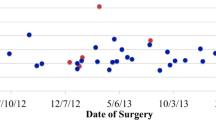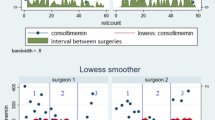Abstract
Objective
This study aimed to demonstrate to the involved departments the goal of increasing the number of robotic-assisted thoracic surgery (RATS) cases/surgeons and acceptable surgery times.
Methods
This retrospective study included 1572 patients who underwent thoracic surgery from fiscal year (FY) 2018 to FY 2021. The factors evaluated included the number of surgery cases and actual and scheduled surgery times.
Results
The total number of RATS and total surgery cases increased after the quality indicator (QI) setting (n = 363, 360, 417, and 432 in FY 2018, 2019, 2020, and 2021, respectively). In FY 2020, 93.3% of the QI target was achieved, while in FY 2021, 88% was achieved. The number of RATS lobectomy/segmentectomy increased as the FY progressed (n = 31, 47, 58, and 116 in FY 2018, 2019, 2020, and 2021, respectively). The mean surgical time by RATS starters decreased in FY 2020 and 2021 (171.4 min.; 74 cases; seven RATS starters) compared with those in FY 2018 and 2019 (198.0 min.; 57 cases; six RATS starters) (P = 0.002).
Conclusions
The goal of increasing the number of surgery cases and RATS cases/surgeons within the given framework was achieved by setting the QI.


Similar content being viewed by others
Data availability
Data that support the findings of this study are available from the corresponding author, N.O., upon reasonable request.
References
Burgette LF, Mulcahy AW, Mehrotra A, Ruder T, Wynn BO. Estimating surgical procedure times using anesthesia billing data and operating room records. Health Serv Res. 2017;52:74–92. https://doi.org/10.1111/1475-6773.12474.
Wynn BO, Burgette LF, Mulcahy AW, Okeke EN, Brantley I, Iyer N, et al. Development of a model for the validation of work relative value units for the Medicare Physician Fee Schedule. Rand Health Q. 2015;5:5.
Suda T. Transition from video-assisted thoracic surgery to robotic pulmonary surgery. J Vis Surg. 2017;3:55. https://doi.org/10.21037/jovs.2017.03.04
Chen-Yoshikawa TF, Fukui T, Nakamura S, Ito T, Kadomatsu Y, Tsubouchi H, et al. Current trends in thoracic surgery. Nagoya J Med Sci. 2020;82:161–74. https://doi.org/10.18999/nagjms.82.2.161
Deen SA, Wilson JL, Wilshire CL, Vallières E, Farivar AS, Aye RW, et al. Defining the cost of care for lobectomy and segmentectomy: a comparison of open, video-assisted thoracoscopic, and robotic approaches. Ann Thorac Surg. 2014;97:1000–7. https://doi.org/10.1016/j.athoracsur.2013.11.021.
Swanson SJ, Miller DL, McKenna RJ Jr, Howington J, Marshall MB, Yoo AC, et al. Comparing robot-assisted thoracic surgical lobectomy with conventional video-assisted thoracic surgical lobectomy and wedge resection: results from a multihospital database (Premier). J Thorac Cardiovasc Surg. 2014;147:929–37. https://doi.org/10.1016/j.jtcvs.2013.09.046.
Worrell SG, Dedhia P, Gilbert C, James C, Chang AC, Lin J, et al. The cost and quality of life outcomes in developing a robotic lobectomy program. J Robot Surg. 2019;13:239–43. https://doi.org/10.1007/s11701-018-0844-z.
Heiden BT, Mitchell JD, Rome E, Puri V, Meyers BF, Chang SH, et al. Cost-effectiveness analysis of robotic-assisted lobectomy for non-small cell lung cancer. Ann Thorac Surg. 2022;114:265–72. https://doi.org/10.1016/j.athoracsur.2021.06.090.
Feczko AF, Wang H, Nishimura K, Farivar AS, Bograd AJ, Vallières E, et al. Proficiency of robotic lobectomy based on prior surgical technique in the Society of Thoracic Surgeons General Thoracic Database. Ann Thorac Surg. 2019;108:1013–20. https://doi.org/10.1016/j.athoracsur.2019.04.046.
Fukui T, Kawaguchi K, Tsubouchi H, Ueno H, Sugiyama T, Mori S, et al. <Editors’ Choice> Learning curve of robotic lobectomy for lung malignancies by certified thoracic surgeons. Nagoya J Med Sci. 2021;83:227–37.
Gharagozloo F, Margolis M, Tempesta B, Strother E, Najam F. Robot-assisted lobectomy for early-stage lung cancer: report of 100 consecutive cases. Ann Thorac Surg. 2009;88:380–4. https://doi.org/10.1016/j.athoracsur.2009.04.039.
Melfi FM, Mussi A. Robotically assisted lobectomy: learning curve and complications. Thorac Surg Clin. 2008;18(289–95):vi–vii. https://doi.org/10.1016/j.thorsurg.2008.06.001.
Lee BE, Korst RJ, Kletsman E, Rutledge JR. Transitioning from video-assisted thoracic surgical lobectomy to robotics for lung cancer: are there outcomes advantages? J Thorac Cardiovasc Surg. 2014;147:724–9. https://doi.org/10.1016/j.jtcvs.2013.10.002.
Monden M. The basic plan to promote cancer control in Japan. Gan To Kagaku Ryoho. 2013;40:559–64. (Japanese)
Ministry of Health, Labour and Welfare. Medical insurance. (in Japanese). Accessed 27Aug 2022. https://www.mhlw.go.jp/stf/seisakunitsuite/bunya/kenkou_iryou/iryouhoken/index.html
Kobayashi K, Ando K, Nakashima H, Machino M, Kanbara S, Ito S, et al. Challenges for Joint Commission International accreditation: performance of orthopedic surgeons based on International Patient Safety Goals. Nagoya J Med Sci. 2021;83:87–92. https://doi.org/10.18999/nagjms.83.1.87
Devkaran S, O’Farrell PN. The impact of hospital accreditation on quality measures: an interrupted time series analysis. BMC Health Serv Res. 2015;15:137. https://doi.org/10.1186/s12913-015-0784-5.
Louie BE, Wilson JL, Kim S, Cerfolio RJ, Park BJ, Farivar AS, et al. Comparison of video-assisted thoracoscopic surgery and robotic approaches for clinical stage I and Stage II non-small cell lung cancer using The Society of Thoracic Surgeons database. Ann Thorac Surg. 2016;102:917–24. https://doi.org/10.1016/j.athoracsur.2016.03.032.
Lee SH, Dai T, Phan PH, Moran N, Stonemetz J. The association between timing of elective surgery scheduling and operating theater utilization: a cross-sectional retrospective study. Anesth Analg. 2022;134:455–62. https://doi.org/10.1213/ANE.0000000000005871.
Pandit JJ, Tavare A. Using mean duration and variation of procedure times to plan a list of surgical operations to fit into the scheduled list time. Eur J Anaesthesiol. 2011;28:493–501. https://doi.org/10.1097/EJA.0b013e3283446b9c.
Acknowledgements
We would like to acknowledge Miku Hattori for deriving data from the electronic medical record system.
Author information
Authors and Affiliations
Corresponding author
Ethics declarations
Conflict of interest
The authors declare no conflicts of interest.
Additional information
Publisher's Note
Springer Nature remains neutral with regard to jurisdictional claims in published maps and institutional affiliations.
Rights and permissions
Springer Nature or its licensor (e.g. a society or other partner) holds exclusive rights to this article under a publishing agreement with the author(s) or other rightsholder(s); author self-archiving of the accepted manuscript version of this article is solely governed by the terms of such publishing agreement and applicable law.
About this article
Cite this article
Ozeki, N., Ueno, H., Saeki, J. et al. Setting a quality indicator for actual surgery time relative to scheduled surgery time in the context of increasing robotic-assisted thoracic surgery cases. Gen Thorac Cardiovasc Surg 71, 396–402 (2023). https://doi.org/10.1007/s11748-022-01903-6
Received:
Accepted:
Published:
Issue Date:
DOI: https://doi.org/10.1007/s11748-022-01903-6




